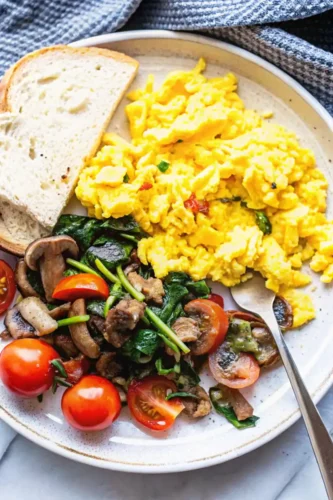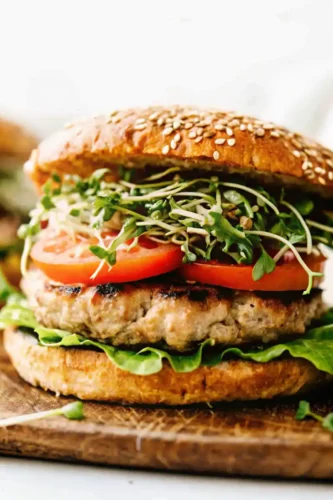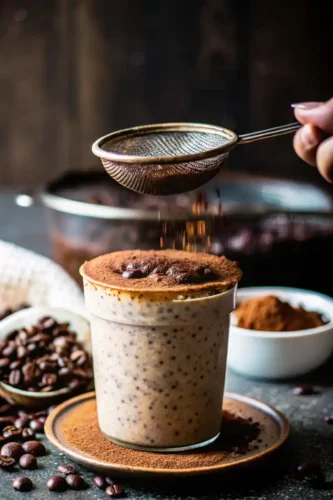If you’ve ever craved that classic nooks-and-crannies texture of an English muffin but need to stick to a gluten-free diet, you’re in for a treat. Gluten-free English muffins are not only possible to make but are every bit as delicious as their traditional counterparts. With just a few simple ingredients and easy techniques, you’ll soon have warm, fluffy muffins perfect for breakfast, snacks, or even as a base for mini pizzas. Let’s dive right in and uncover the magic of these delightful, versatile treats.
JUMP TO
- Why You’ll Love Gluten-Free English Muffins
- What Are Gluten-Free English Muffins?
- Health Benefits of Gluten-Free English Muffins
- Ingredients You’ll Need
- How to Make Gluten-Free English Muffins at Home
- Pro Tips for Perfect Gluten-Free English Muffins
- Storage and Freezing Instructions for Gluten-Free English Muffins
- Delicious Ways to Enjoy Gluten-Free English Muffins
- FAQs About Gluten-Free English Muffins
- Latest Recipes to Inspire Your Next Meal
Why You’ll Love Gluten-Free English Muffins
English muffins have long been a breakfast staple, and making them gluten-free adds an exciting twist. Here’s why you’ll absolutely love them:
Perfect for Every Meal
Whether you’re toasting them for a quick breakfast, using them as a base for eggs benedict, or turning them into sandwiches, gluten-free English muffins are incredibly versatile. They’re soft, chewy, and adaptable for both sweet and savory toppings.
A Healthier Option
Gluten-free baking often includes nutrient-dense ingredients like almond flour or sorghum, which provide added health benefits compared to regular wheat flour. You get to enjoy a classic comfort food with a better nutritional profile.
Homemade Bliss
Making these muffins from scratch allows you to control the ingredients. Want them dairy-free? No problem! Looking for a vegan option? It’s simple to tweak the recipe. Plus, there’s nothing quite like the satisfaction of baking your own bread.
For more gluten-free baking inspiration, check out our Gluten-Free Biscuits, which pair perfectly with jam or honey for breakfast delights.
What Are Gluten-Free English Muffins?
When it comes to breakfast favorites, gluten-free English muffins are a rising star. But what exactly makes them different from the classic version? Let’s explore the key characteristics of these delicious baked goods and how they stand apart.
Understanding Gluten-Free Baking
Gluten-free baking is all about replacing traditional wheat flour with alternatives like almond flour, rice flour, or sorghum flour. These options lack gluten—the protein responsible for the elasticity and structure in baked goods—so the challenge lies in recreating the same texture and chew.
To achieve that soft and fluffy interior with the iconic nooks and crannies, gluten-free recipes often use binders like xanthan gum, psyllium husk, or flaxseed meal. These ingredients mimic gluten’s properties, ensuring your muffins hold together beautifully.
How They Differ from Regular English Muffins
The primary difference is, of course, the absence of gluten. This results in a slightly denser texture, but don’t let that fool you—gluten-free English muffins are equally satisfying. They also tend to have a more subtle, nutty flavor, thanks to the alternative flours used.
Unlike regular muffins, gluten-free ones often have a shorter shelf life due to their natural ingredients. But don’t worry! They’re easy to store and freeze, making them perfect for meal prep. Speaking of freezing, you’ll want to check out our tips for keeping them fresh later in this guide.
For more insight into gluten-free baking, be sure to visit our Gluten-Free Bread Crumbs guide to expand your gluten-free culinary repertoire.
Health Benefits of Gluten-Free English Muffins
Switching to a gluten-free lifestyle isn’t just for those with gluten intolerance or celiac disease; it can also offer a range of health benefits. Gluten-free English muffins, in particular, are a fantastic choice for anyone looking to enjoy a classic breakfast staple without compromising on health.
Great for Gluten-Sensitive Individuals
For those with celiac disease or gluten sensitivity, consuming gluten can lead to severe discomfort and digestive issues. Gluten-free English muffins eliminate this concern, allowing you to enjoy a safe and delicious treat.
But wait—there’s more! Because these muffins rely on nutrient-rich ingredients like almond flour, they’re often packed with healthy fats, protein, and fiber, making them a more nourishing choice than traditional varieties.
A Nutrient-Rich Alternative
Gluten-free English muffins often contain wholesome ingredients like sorghum flour, which is high in antioxidants, or rice flour, which is gentle on the digestive system. Some recipes even include seeds or flax meal for an extra boost of omega-3 fatty acids and essential nutrients.
By baking them at home, you can control what goes into your muffins. Opt for organic ingredients, reduce sugar, or even add a dash of superfoods like chia seeds. That means your muffins can support a healthier diet while still being a comfort food.
Ingredients You’ll Need
Making gluten-free English muffins at home is simpler than you might think. The best part? You can tailor the ingredients to suit your dietary preferences or allergies. Below is a detailed list of ingredients to ensure your muffins come out fluffy, flavorful, and perfectly textured.
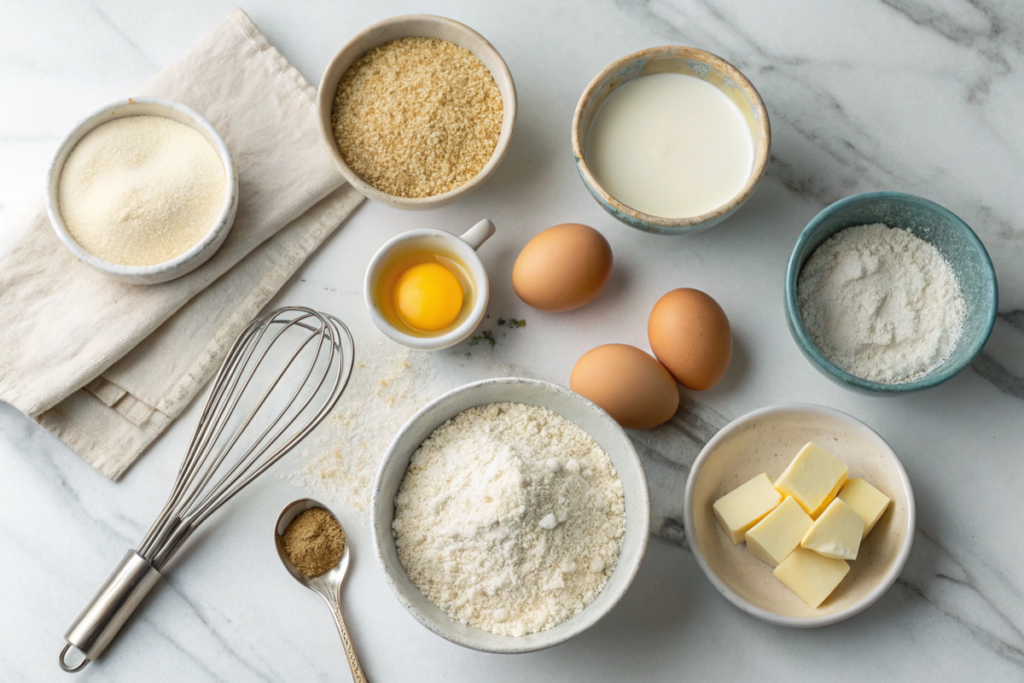
Essential Gluten-Free Ingredients
- 2 cups (240g) gluten-free flour blend: Choose a blend containing rice flour, potato starch, and tapioca starch for the best results.
- 1/2 cup (60g) almond flour: Optional, but adds a rich and moist texture.
- 1 teaspoon xanthan gum or psyllium husk: Acts as a binder to replace gluten.
- 1 packet (2 1/4 teaspoons or 7g) instant yeast: Helps the muffins rise and achieve their airy texture.
- 3/4 cup (180ml) warm milk or water: Use a non-dairy option like almond or oat milk if needed. The liquid should be warm (about 110°F/43°C) to activate the yeast.
- 1 tablespoon granulated sugar or honey: Feeds the yeast and adds a hint of sweetness.
- 1/2 teaspoon salt: Balances the flavors.
- 2 tablespoons (28g) unsalted butter or dairy-free alternative: Softened, to add moisture and tenderness.
- 1 large egg: Adds structure and lightness. For egg-free muffins, replace with 1 flax egg (1 tablespoon ground flaxseed + 3 tablespoons water, mixed and rested for 5 minutes).
Optional Add-Ins for Flavor
- 1 teaspoon dried herbs (e.g., rosemary, thyme): For savory muffins.
- 1/2 teaspoon cinnamon or 1 teaspoon vanilla extract: For a sweet twist.
Substitutions
- Replace almond flour with an additional 1/4 cup (30g) gluten-free flour blend if nut-free.
- Use coconut oil or vegan butter instead of regular butter for a dairy-free option.
- Substitute honey with maple syrup for a plant-based sweetener.
How to Make Gluten-Free English Muffins at Home
Now that you have your ingredients ready, it’s time to turn them into soft, fluffy, and delicious gluten-free English muffins. Follow this step-by-step guide to ensure your muffins come out perfectly every time.
Prepare the Dough
- In a small bowl, mix 3/4 cup warm milk or water (about 110°F/43°C) with 1 tablespoon sugar and 1 packet (2 1/4 teaspoons) instant yeast. Stir gently and let it sit for 5–10 minutes until the mixture becomes foamy. This activates the yeast.
- In a large mixing bowl, combine 2 cups gluten-free flour blend, 1/2 cup almond flour, 1 teaspoon xanthan gum, and 1/2 teaspoon salt. Whisk these dry ingredients to ensure they are evenly distributed.
- Add the yeast mixture, 2 tablespoons softened butter, and 1 large egg (or flax egg if making egg-free muffins) to the dry ingredients. Mix until the dough comes together. It should be slightly sticky but manageable.
Knead and Rest
- Lightly flour a clean surface with gluten-free flour and knead the dough for 2–3 minutes. If it feels too sticky, sprinkle a little more flour, but avoid over-flouring.
- Shape the dough into a ball and place it in a lightly greased bowl. Cover with a damp kitchen towel and let it rest in a warm spot for 1–2 hours or until it doubles in size.
Shape the Muffins
- Once the dough has risen, punch it down gently to release excess air. Divide it into 6–8 equal portions, depending on your preferred muffin size.
- Roll each portion into a ball and flatten slightly to form discs about 1 inch thick. Dust the discs lightly with gluten-free flour to prevent sticking.
Cook the Muffins
- Heat a non-stick skillet or griddle over medium-low heat. Sprinkle a thin layer of cornmeal onto the skillet to give the muffins their signature texture.
- Place the muffin discs onto the skillet, leaving enough space between each. Cook for 5–7 minutes on each side, or until golden brown and firm. Adjust the heat if necessary to prevent burning while ensuring the centers cook through.
Cool and Serve
- Transfer the cooked muffins to a wire rack and let them cool completely. Cooling helps set their structure, making them easier to slice.
- Once cooled, use a fork to split the muffins for the best texture. Toast and serve with your favorite toppings like butter, jam, avocado, or even a fried egg.
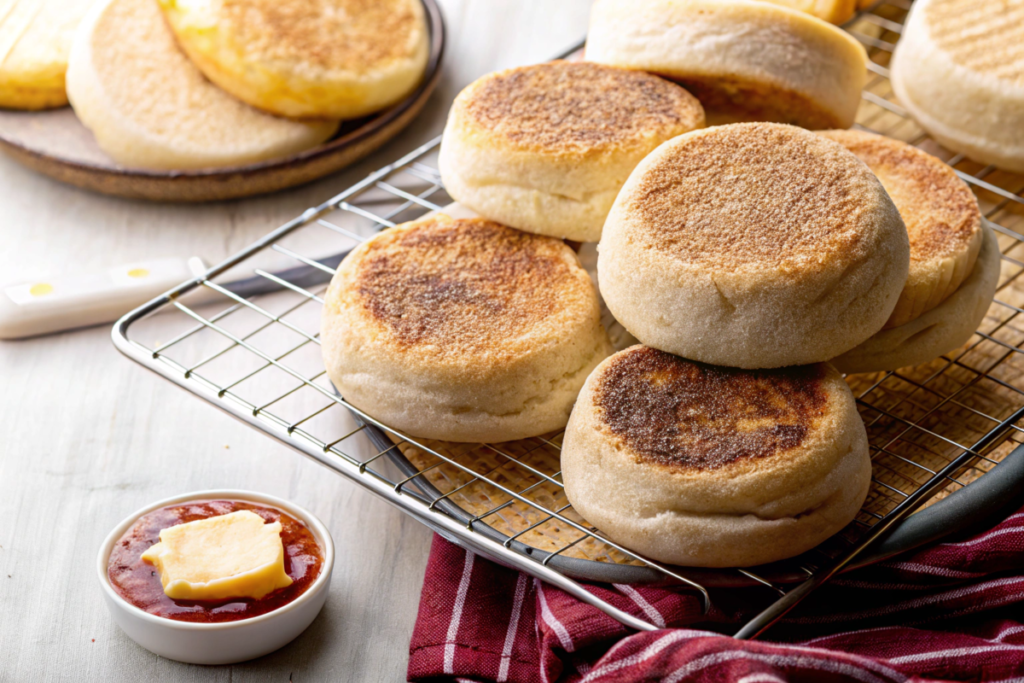
Pro Tips for Perfect Gluten-Free English Muffins
Achieving bakery-quality gluten-free English muffins at home might seem challenging, but with these expert tips, you’ll be a pro in no time. Let’s ensure your muffins come out light, fluffy, and bursting with flavor every single time.
Achieving the Perfect Texture
- Don’t Skip the Rest Time: Allowing the dough to rest is crucial for letting the yeast do its work. This step ensures your muffins rise well and have a soft, airy texture.
- Use Warm Liquids: The liquid temperature should be around 110°F/43°C. Too hot, and it can kill the yeast; too cold, and the yeast won’t activate properly.
- Handle the Dough Gently: Over-kneading can make gluten-free dough too dense. A light hand will yield the best results.
Secrets for Nooks and Crannies
- Fork Splitting Is Key: Instead of slicing the muffins with a knife, use a fork to gently pry them apart. This creates those classic nooks and crannies perfect for holding butter and jam.
- Low and Slow Cooking: Cooking on low to medium-low heat ensures the muffins cook evenly all the way through without burning the exterior.
Troubleshooting Common Issues
- Sticky Dough?: Gluten-free doughs are naturally stickier than regular doughs. Sprinkle just enough flour to manage it, but don’t overdo it—too much flour will make the muffins dry.
- Flat Muffins?: This usually happens if the yeast didn’t activate properly. Double-check the liquid temperature and ensure the yeast is fresh.
- Dry Texture?: Add a tablespoon of olive oil or an extra egg yolk to the dough next time to enhance moisture.
Experimenting with Add-Ins
Feel free to personalize your muffins! Adding grated cheese, chopped herbs, or even dried fruits like raisins can elevate your muffins into something truly unique.
Storage and Freezing Instructions for Gluten-Free English Muffins
Once you’ve perfected your gluten-free English muffins, you’ll want to ensure they stay fresh and delicious for as long as possible. Whether you’re saving them for breakfast tomorrow or stocking up for weeks ahead, these storage and freezing tips will help you keep them at their best.
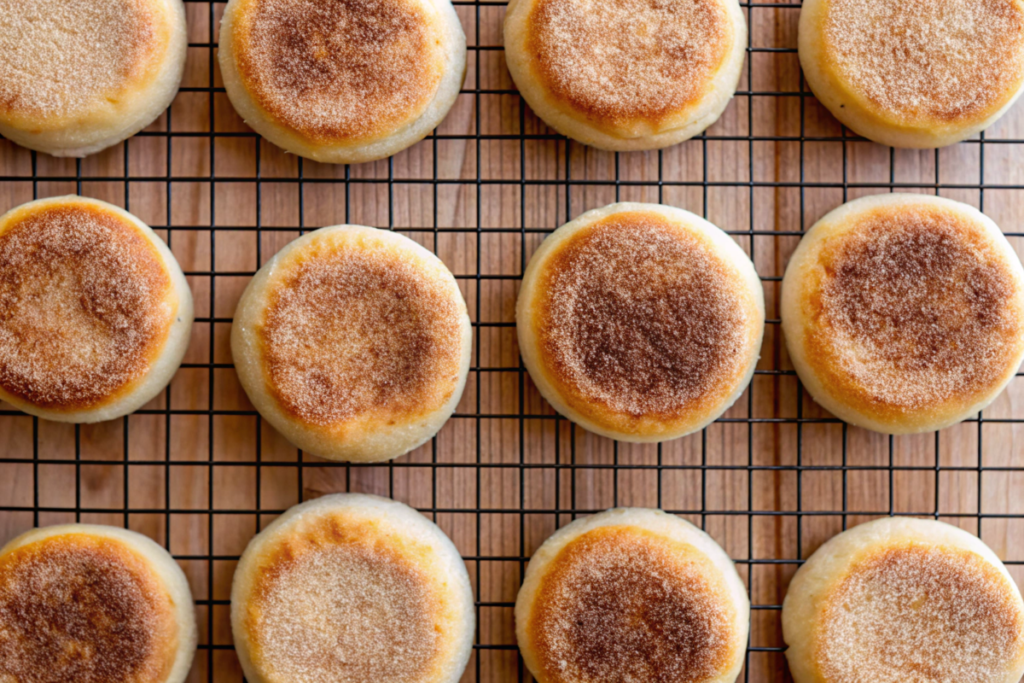
How to Store Fresh Muffins
- Room Temperature: Place completely cooled muffins in an airtight container or resealable plastic bag. They’ll stay fresh for up to 2 days at room temperature.
- Pro tip: Add a paper towel inside the container to absorb moisture and prevent sogginess.
- Refrigeration: For longer storage, refrigerate the muffins. Keep them in an airtight container to maintain freshness. They’ll last up to 5 days in the fridge.
Freezing Tips for Longer Shelf Life
Freezing is an excellent way to preserve your gluten-free muffins for weeks or even months. Follow these steps to freeze them properly:
- Cool Completely: Ensure the muffins are entirely cool before freezing to prevent ice crystals from forming.
- Individually Wrap: Wrap each muffin tightly in plastic wrap or aluminum foil. This prevents freezer burn and helps maintain their flavor.
- Store in a Freezer Bag: Place the wrapped muffins in a freezer-safe bag or container. Label it with the date for easy tracking.
- Freezing Duration: Gluten-free English muffins can be frozen for up to 3 months without losing quality.
How to Thaw and Reheat
- Thawing: Remove the muffins from the freezer and let them thaw at room temperature for about 30 minutes.
- Reheating: Slice the muffins in half and toast them lightly in a toaster or on a griddle. If they were frozen, they might need a bit more time to heat through.
Delicious Ways to Enjoy Gluten-Free English Muffins
Gluten-free English muffins are incredibly versatile and can be transformed into endless meal possibilities. Whether you prefer savory breakfasts or indulgent desserts, these ideas will inspire you to enjoy your muffins in unique and delicious ways.
Breakfast Favorites
- Classic Toast with Butter and Jam
- A timeless option that highlights the muffins’ flavor. Try pairing them with homemade jam for an extra treat.
- Avocado Smash
- Top your toasted muffin with mashed avocado, a drizzle of olive oil, and a sprinkle of sea salt for a healthy, filling start to the day.
- Eggs Benedict
- Use your muffins as the base for poached eggs, ham (or a vegetarian substitute), and creamy hollandaise sauce.
Savory Snack Ideas
- Mini Pizzas
- Spread marinara sauce on a halved muffin, sprinkle with shredded cheese, and top with your favorite vegetables. Bake until bubbly for a quick snack.
- Breakfast Sandwiches
- Layer scrambled eggs, turkey sausage, and cheese between two muffin halves for a hearty, portable meal.
- Garlic Herb Muffins
- Toast the muffins and rub with garlic, then spread with butter and sprinkle with fresh herbs for an easy side dish.
Sweet Treats
- Cinnamon Sugar Delight
- Toast the muffin, brush it with melted butter, and sprinkle generously with cinnamon sugar. It’s like having dessert for breakfast!
- Berry and Cream Delight
- Top with a dollop of whipped cream and fresh berries for a light, fruity treat.
- Nut Butter and Honey
- Spread your favorite nut butter on a toasted muffin, then drizzle with honey for a quick and satisfying snack.
Creative Pairings
- Pair with Blended Overnight Oats for a complete breakfast spread.
- Serve alongside soups like our 4-Ingredient Potato Soup for a comforting lunch or dinner.
- Enjoy with a warm Dirty Chai Latte for a cozy, spiced beverage that perfectly complements the muffins’ flavors.
FAQs About Gluten-Free English Muffins
Are English muffins gluten-free?
Traditional English muffins are typically made with wheat flour, which contains gluten. However, gluten-free English muffins use alternative flours like rice flour, almond flour, or sorghum flour to make them safe for those avoiding gluten. Always check the label or make them at home using gluten-free ingredients to ensure they’re truly gluten-free.
Are potatoes gluten-free?
Yes, potatoes are naturally gluten-free. They are a versatile and safe option for those with gluten intolerance or celiac disease. Whether boiled, mashed, or fried, potatoes can be enjoyed without worrying about gluten. Just be cautious of added ingredients like seasonings or sauces that may contain gluten.
Is sourdough bread gluten-free?
Traditional sourdough bread is not gluten-free because it is typically made with wheat flour. However, gluten-free sourdough recipes use alternative flours, such as brown rice or tapioca flour, to recreate the tangy flavor and texture without gluten. For more ideas and breakfast options featuring sourdough, explore our Sourdough Breakfast Recipes for delicious inspiration!
Do gluten-free muffins taste different?
Gluten-free muffins can taste slightly different from their wheat-based counterparts due to the unique flavors of alternative flours like almond or rice flour. They often have a nutty or subtly sweet flavor and a denser texture. With the right recipe and ingredients, gluten-free muffins can be just as delicious, if not more so!




